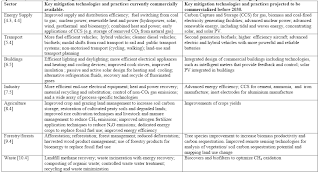A summary of these reports is presented in the following two tables that estimate the economic mitigation potential for a given level of carbon taxation by 2030. In the previous blog the term economic potential is defined. In the second blog in this series the scenarios A1B and B2 were presented with a graph of projected emissions in 2030 using the scenarios.
Estimates of economic mitigation potential by 2030, using bottom-up studies:

Note that the bottom up analysis anticipates potential mitigation even at a zero carbon tax.
Estimates of economic mitigation potential by 2030, using top-down studies:

The baseline emissions for 2000 were 43 Gigatonnes CO2-equivalent, so against scenario A1B we would need to see mitigation of 25GtCO2-eq/yr and 6GtCO2-eq/yr against scenario B2 to return to year 2000 emissions levels. To achieve this would require an expected carbon tax of $100 in scenario A1B but could potentially be achieved at zero cost in scenario B2. That's assuming that the baseline of year 2000 emissions doesn't lead to climate change.
The report looks at various sectors of the economy and looks at existing and future commercial technologies that could mitigate GHG emissions. Click the table to open in a new window.

And from these the report comes up with the following sectoral estimates of economic potential for global mitigation by 2030.

This table shows that the building sector has the largest economic potential for mitigation of GHG emissions. However, the sectors studied used different baselines!!! So, what I would take from this is that carbon taxation isn't necessarily a very effective way of reducing emissions in most sectors.
What will this cost?
According to the report, reaching GHG emissions consistent with stabilising concentrations of GHG in the atmosphere to between 445 and 710 ppm (parts per million) CO2-eq will cost the global economy up to 3% of world GDP. It further notes that regional costs may vary significantly from global averages (but doesn't provide any data on the differences).

My thoughts:
The level of GHG in the atmosphere in 2005, was 427 ppm CO2-eq against pre-industrial levels of 278 ppm CO2-eq according to the European Environmental Agency website. I think it is a good debating point as to whether 710 ppm CO2-eq constitutes a responsible target for stabilising emissions.
No comments:
Post a Comment